Introduction
A SWOT analysis is a powerful tool that helps organizations evaluate their internal strengths and weaknesses, as well as external opportunities and threats. By embracing this analysis framework, businesses can gain insight into their operational landscape and chart a tailored course of action. In this article, we will explore what a SWOT analysis is, why it is important to use, how to conduct one effectively, and provide real-world examples of its application.
Whether you are a family-owned restaurant, a tech startup, or a retail business, understanding how to leverage your strengths, mitigate weaknesses, and navigate external opportunities and threats is crucial for long-term success. Join us as we delve into the actionable steps to transform SWOT analysis insights into strategic actions and discover additional resources that can help you leverage this tool in your own organization.
What is a SWOT Analysis?
A SWOT analysis serves as a critical instrument for strategic planning, enabling an organization to meticulously evaluate its internal strengths and weaknesses along with the external opportunities and threats it faces. Embracing this analysis framework equips businesses with the foresight and clarity to navigate their market position and propel their strategic endeavors forward. For instance, strengths may include unique competencies or resources that provide competitive advantage, whereas weaknesses might encompass areas that require improvement or investment.
Opportunities often present as external factors that the business can exploit for growth, and threats encompass potential challenges such as shifts in market dynamics or emerging competition. Employing SWOT analysis, companies of all life stages can gain profound insights into their operational landscape, and chart out a tailored course of action that emphasizes leveraging inherent strengths, mitigating weaknesses, strategically exploiting opportunities, and efficiently neutralizing threats.
The external environment poses numerous challenges and opportunities for businesses, often beyond their direct control. For instance, climate change impacts, such as droughts and bushfires, can disrupt supply chains, prompting companies to adopt comprehensive sustainability measures. The pressing need to achieve net-zero emissions has led to significant corporate commitments globally.
Meanwhile, technological advancements, such as the Swarm app, have revolutionized energy management in homes by providing unified control over diverse smart devices. Furthermore, automated tools like the SWA are streamlining operational plan development by exploiting digital data more effectively. This enhancement in planning capabilities enables organizations to react swiftly to emerging strategic landscapes, a principle underlined by the rapid accomplishments demonstrated in initial trials of the SWA tool.
To fully utilize the SWOT framework's potential, organizations are encouraged to consider pivotal questions that clarify their objectives and identify their conceivable threats, ranging from economic factors, like escalating material costs, to labor market challenges. By addressing these elements within a structured analysis template, businesses can better understand the internal and external forces at play, align strategies with their capacities, and subsequently fortify their long-term viability and success.
Why Use a SWOT Analysis?
A SWOT analysis provides a crystalline framework for businesses to gauge their competitive position and strategize accordingly. This tool assists in identifying the internal strengths unique to an organization—such as outstanding employees, robust financial health, or advanced technological capabilities. By understanding internal dynamics, businesses can harness their unique attributes to stand out in their industry.
It doesn't stop there; the SWOT framework also illuminates potential weaknesses within a firm, allowing for a proactive approach to manage any vulnerabilities. Externally, the analysis is adept at spotlighting opportunities ripe for capture, as well as flagging potential threats on the horizon—factors that dwell outside the company's control, ranging from economic shifts to competitive movements. It's through this encompassing view that businesses are equipped with actionable intelligence, enabling them to craft strategies that leverage internal strengths to maximum advantage while nimbly navigating around weaknesses and external unpredictabilities.
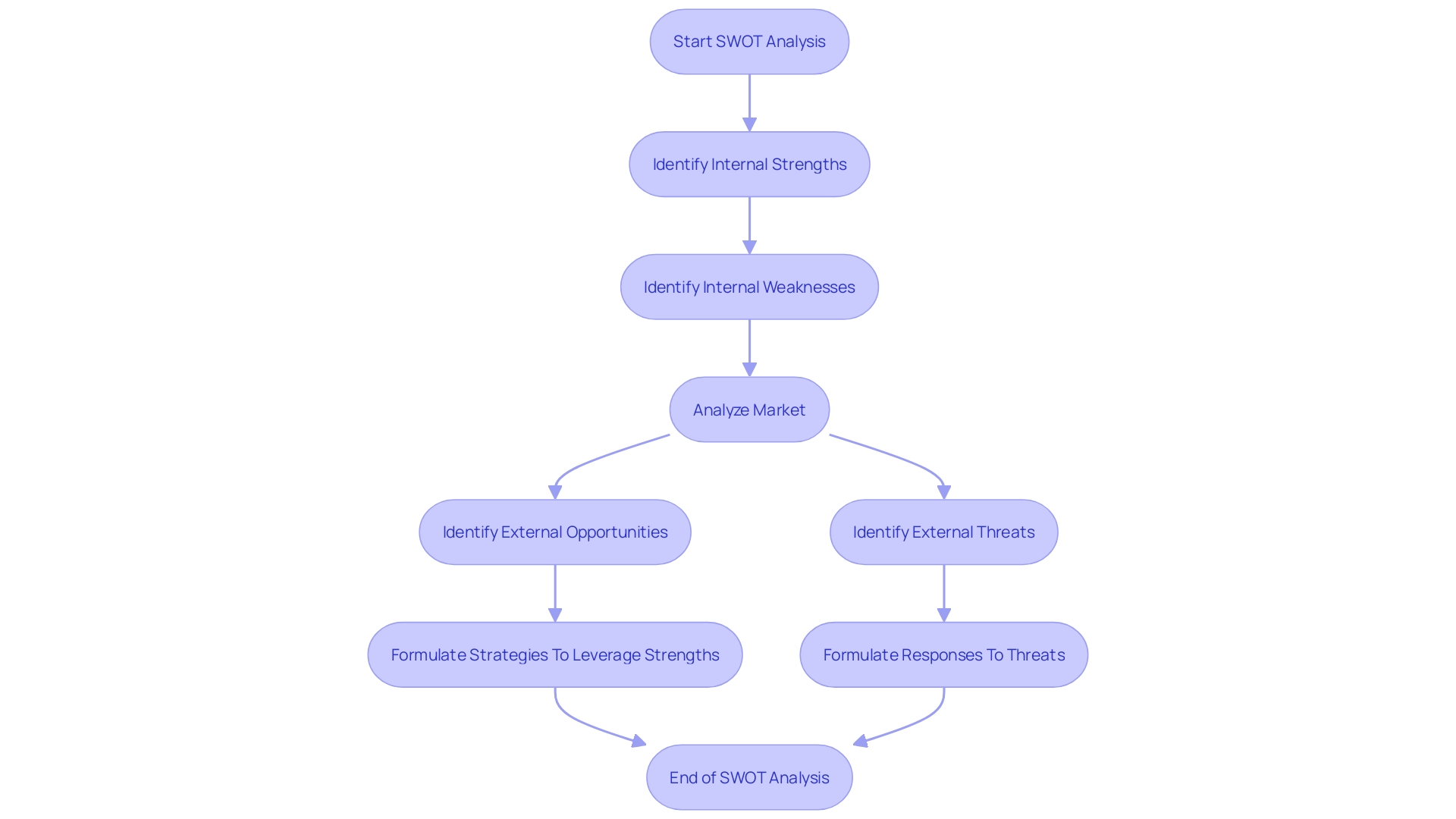
How to Conduct a SWOT Analysis
Embarking on a SWOT analysis is a methodical approach to evaluating your business's strategic position. The initial step requires amassing data to scrutinize the internal dimensions—your corporate strengths and weaknesses—as well as external variables such as potential opportunities and probable threats. This process comprises:
- Distinguishing what delineates your venture in a positive light, pinpointing areas of superiority.
- Recognizing spheres demanding enhancement or factors placing the business at a disadvantage.
- Scouting for external elements poised to favorably influence the venture or foster expansion.
- Identifying potential external challenges or hindrances adverse to the business trajectory.
Upon gathering this intelligence, critical evaluation and ranking based on the anticipated effect on the enterprise ensue. Eventually, the insight gleaned from this analysis is wielded to forge strategies to augment inherent strengths, offset weaknesses, seize on external opportunities, and counter external threats.
Leveraging the SWOT model provides a panoramic view of your organization and uncovers blindspots previously unnoticed. Not merely reserved for business strategy discussions, SWOT is instrumental during early stages of strategic planning, market position assessment, or preceding significant corporate maneuvers. It offers a snapshot of your company's health and guides decisions on where to channel energies moving forward.
For example, a business's strengths might embody robust financial resources, cutting-edge technology, or a skilled workforce—attributes propelling it ahead of the competition. Contrarily, threats manifest as events outside your control, such as economic downturns or surges in material costs, necessitating the evaluation of potential risks and the formation of contingency plans to buffer against such untoward occurrences.
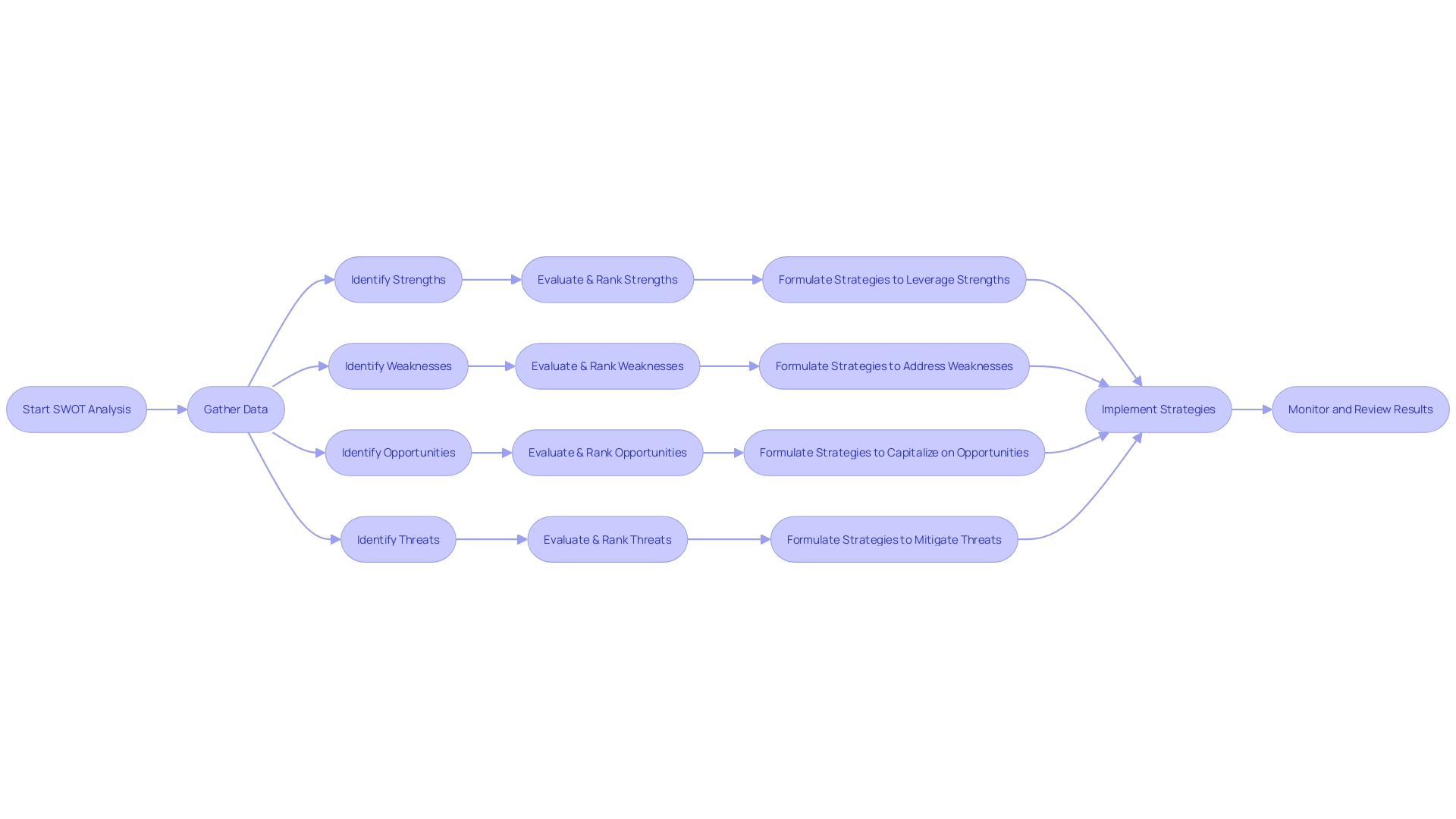
Real-world Examples of SWOT Analysis
Dive into the practical application of SWOT analysis with real-world examples, and gain insights into how organizations harness this versatile tool. A deeper understanding of SWOT—identifying strengths, weaknesses, opportunities, and threats—can lead to robust strategic planning. It's used by businesses to pinpoint their unique position in the marketplace.
The core objective: to foster strategies that utilize a company's individual strengths, mitigate weaknesses, and adapt responsively to the environment. Consider the internal factors such as a firm's human resources, sound financial standing, or innovative technological edge that contribute to its distinctive capabilities.
In the face of evolving markets, companies must adapt, and often, reskilling becomes paramount. Consider the executives facing the challenge of reskilling 40% of the workforce due to AI and automation impacts over three years. These shifts necessitate a SWOT analysis for efficient strategic realignment.
Similarly, firms like Cisco identify strengths in their AI and security ventures, steering away from traditional networking equipment roots towards data security and software, thereby highlighting strategic pivots using SWOT principles.
Applying a SWOT analysis provides a comprehensive view of a business, aiding in decision-making for major strategic moves, market position evaluation, or even specific project assessments. It's a tool that doesn't just identify current standings but also helps uncover potential issues previously unnoticed, offering a well-rounded perspective for leveraging strengths and supplementing areas of improvement.
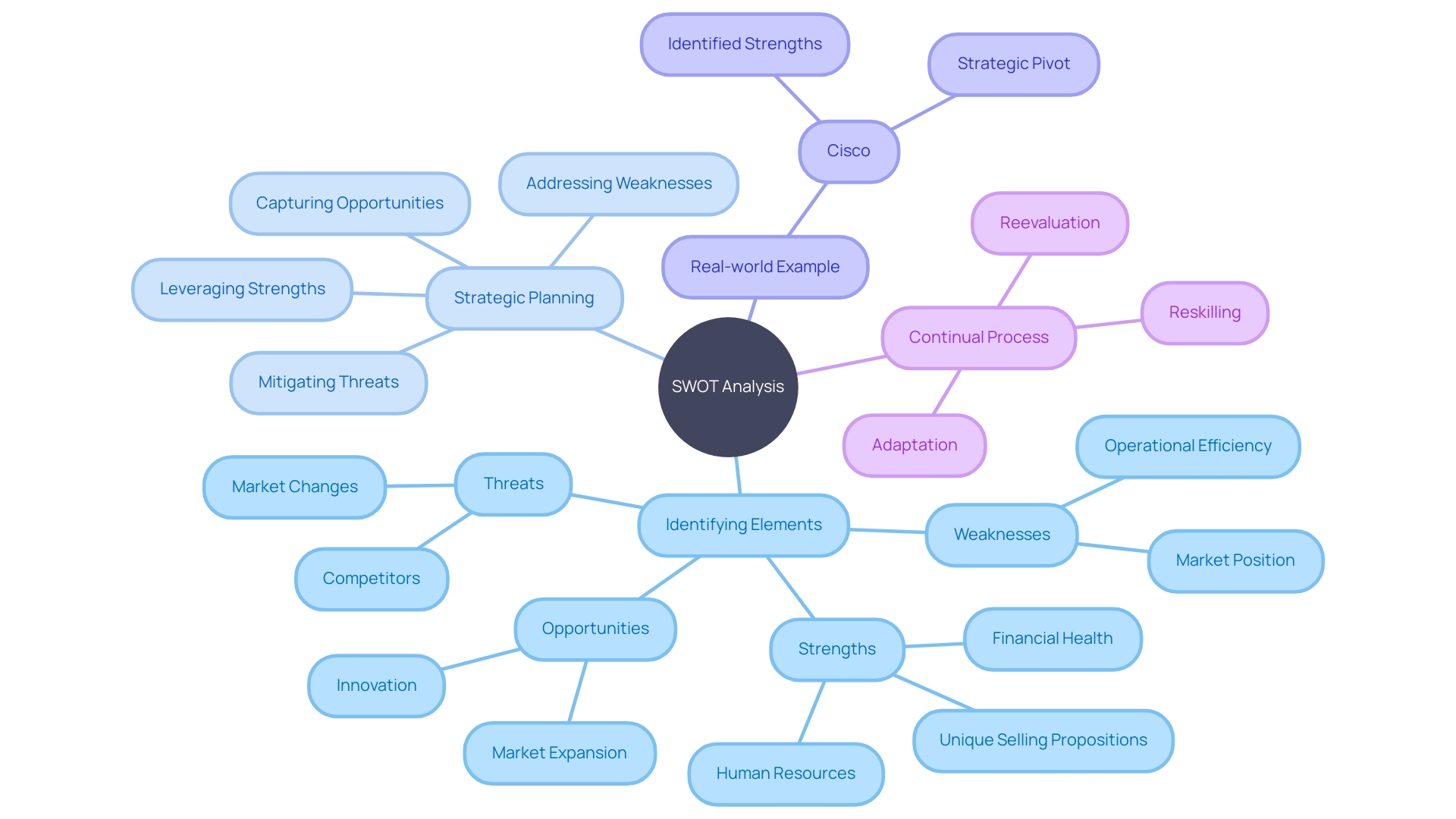
Example 1: Family-Owned Restaurant
A family-owned restaurant, attuned to its heritage and customer loyalty, utilized a SWOT analysis to navigate its market position and unveil actionable strategies. The exercise pinpointed the establishment's bedrock: the unwavering patronage of their clientele and the distinctiveness of their family recipes—an advantage commonly seen in multi-generational family-owned businesses (Fobs) which contribute significantly to the global economy. Weaknesses such as a minimal online footprint and dated interiors emerged, juxtaposing against the potential to tap into the burgeoning demand for local, organic cuisine.
Notably, with the specter of increasing competition from larger chains, strategic intervention became imperative.
Emboldened by the analysis, the restaurant devised a multipronged approach: amplifying its digital presence to strengthen customer engagement, refurbishing its space to enhance dining ambiance, and mounting a marketing initiative that accentuates its commitment to locally sourced, organic fare. These strategic moves mirror the successes of businesses like Travel Charme Hotels & Resorts, which by harnessing technology, fortified operations and guest experiences in their unique holiday hotels.
Such targeted enhancements are not merely about aesthetics or trends; they connect with wider industry insights indicating a preference for authenticity and quality—a strategy endorsed by experts like John Young, who asserts that understanding one's market is pivotal. Subsequently, a similar establishment achieved rave reviews and a substantial uptick in sales by capitalizing on its location and crafting a fitting strategy.
This example underscores that a well-executed SWOT analysis can propel FOBs to thrive amidst challenges, leveraging their unique strengths and seizing opportunities that align with their distinct values and business goals.
Example 2: Tech Startup
A fledgling tech startup recently leveraged SWOT analysis to map out its current market standing and project its trajectory of growth. The analysis honed in on the company's innovative product and adept team as key strengths, while also acknowledging the challenges of insufficient funding and low brand awareness as weaknesses. Sizing up the marketplace, they spotted burgeoning demand for their product's distinctive features and potential alliances with well-established industry figures as meaningful opportunities.
Concurrently, the startup acknowledged the presence of formidable adversaries in well-entrenched tech conglomerates as a significant threat. With these insights, the startup charted a course of action that included bolstering their capital reserves, crafting a savvy marketing initiative, and seeking out strategic partnerships to catalyze their expansion.
Insights from industry data, like PitchBook's findings that deep tech startups are prime for investment and building, dispel myths about outcomes and capital intensity, lending credence to this startup's approach. Incorporating a methodical approach is vital, beginning with ideation nurtured in academic or industrial research settings, leading to scientific breakthroughs or engineering feats with potential applications ripe for commercialization. This startup embraced a ruthless focus on execution, rooted in a scrappy mentality and informed by the founders' acute understanding of existing gaps in technology and science.
This strategy reflects the evolving landscape highlighted in recent evaluations of companies like Robinhood Markets and MarketWise, where the software industry's capacity for growth is well-recognized among a discerning, affluent readership.
A SWOT analysis not only provides a balanced overview of a business—it uncovers previously unnoticed blind spots and leverages strengths to tackle weaknesses and threats head-on, as echoed by experts in the field. The agility demonstrated by these startups, with their “anything-product” approach as exemplified by companies like IKEA and Dropbox, underpins their capacity to carve out new market niches, avoiding head-on competition with existing giants. This startup's path, reinforced by the entrepreneurial lessons of tech forerunners like Microsoft and Google, illustrates the effectiveness of a strategically-oriented SWOT analysis in navigating a tech startup's path through a competitive landscape.
Example 3: Retail Business
A retail establishment recently undertook a strategic SWOT analysis to sharpen its understanding of the business landscape and identify optimization strategies. The study highlighted the store's broad merchandise selection coupled with robust customer loyalty as key strengths within the commercial sphere. However, it wasn't without its challenges; the antiquated point-of-sale technology and a minimal digital footprint marked significant weaknesses.
The surge in online shopping and burgeoning opportunities for synergy with community craftsmen stood out as actionable opportunities. Concurrently, the looming shadow of e-commerce titan competition signified a tangible threat. Strategically responding to these insights, the retail outlet prioritized technological upgrades, embraced e-commerce, and enriched its product line through local artisan partnerships - actions which have been vital in reinforcing its market presence.
Actionable Steps After a SWOT Analysis
Transforming the insights from a SWOT analysis into strategic actions is crucial for propelling a company forward. Let's dive into how this can be accomplished:
- Leveraging Strengths to Seize Opportunities: Simply pinpointing strengths is not enough; it's about aligning them strategically with emerging opportunities. Spotify, for example, utilized its strong brand and technological edge to diversify into podcasts and audiobooks, capturing new markets and engaging users in fresh ways.
- Converting Weaknesses to Fortify the Business: An honest appraisal of weaknesses allows a business to form initiatives for improvement. For example, using advanced analytics to overhaul marketing strategies could turn a lack of market presence into a competitive advantage.
- Mitigating Threats to Guard Your Standing: A proactive approach to potential threats can safeguard your business. For instance, a company might anticipate regulatory changes and adapt its compliance strategies accordingly, thus averting possible setbacks.
It's not about one-off changes but rather about a continuous strategic alignment with the business environment. To illustrate, an analysis might uncover that customer experience is a key differentiator, prompting a shift towards improving quality and service to heighten customer satisfaction.
By adopting these actionable steps, a business can channel SWOT insights into a robust growth trajectory, ensuring that goals are not just set but met with precision.
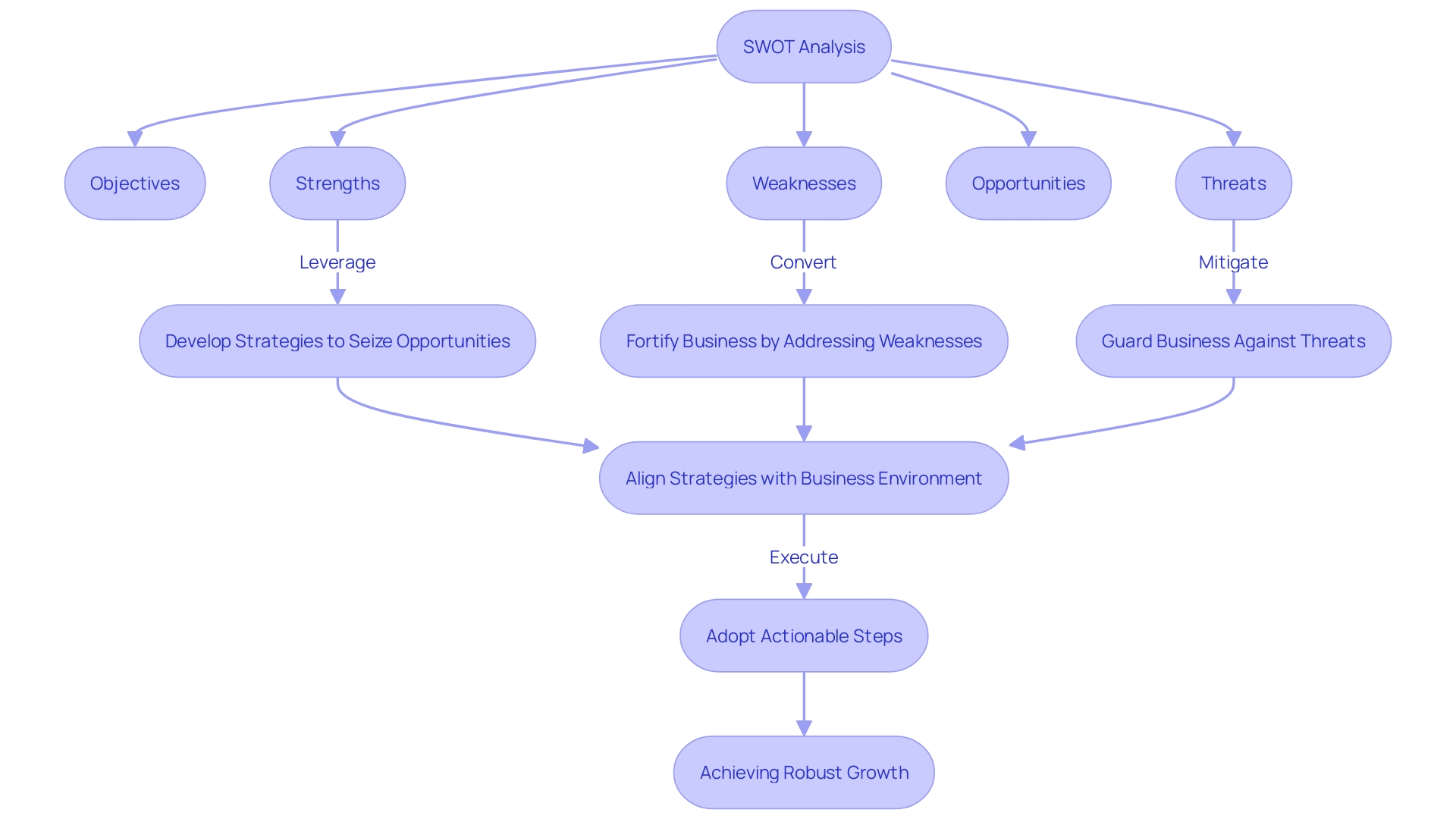
Additional Resources
- For a deep dive into SWOT analysis, consider Guthrie Clinic's holistic approach to healthcare, covering not only medical but also the emotional and social needs of the community. This case can illustrate the impact of a comprehensive internal strengths assessment.
- Spotify's remarkable growth story—evolving from a nascent start-up to a global audio streaming behemoth—showcases the power of identifying market opportunities and the value of strengths like user-friendly interfaces and vast content libraries.
- Pinpointing potential threats and opportunities as early as possible is crucial, especially for start-ups. For example, consider how initial SWOT analyses can set a clear trajectory, preparing new businesses for future regulatory changes or competitive pressures.
These case studies, alongside current news of entrepreneurial innovations such as apps developed to tackle social issues or advancements in eco-friendly technology, can provide vivid, real-world examples of SWOT in action. They underscore how informed decision-making and strategic planning can drive success across diverse industries and societal goals.
By examining these examples and understanding key business planning questions such as the distinction between business and strategic plans, you can emerge well-equipped to apply SWOT to your own company's strategy. Notably, a SWOT analysis will help craft strategies to leverage your organization's distinctive strengths and address weaknesses—both critical for CFOs concerned with managing risk and achieving long-term fiscal health.
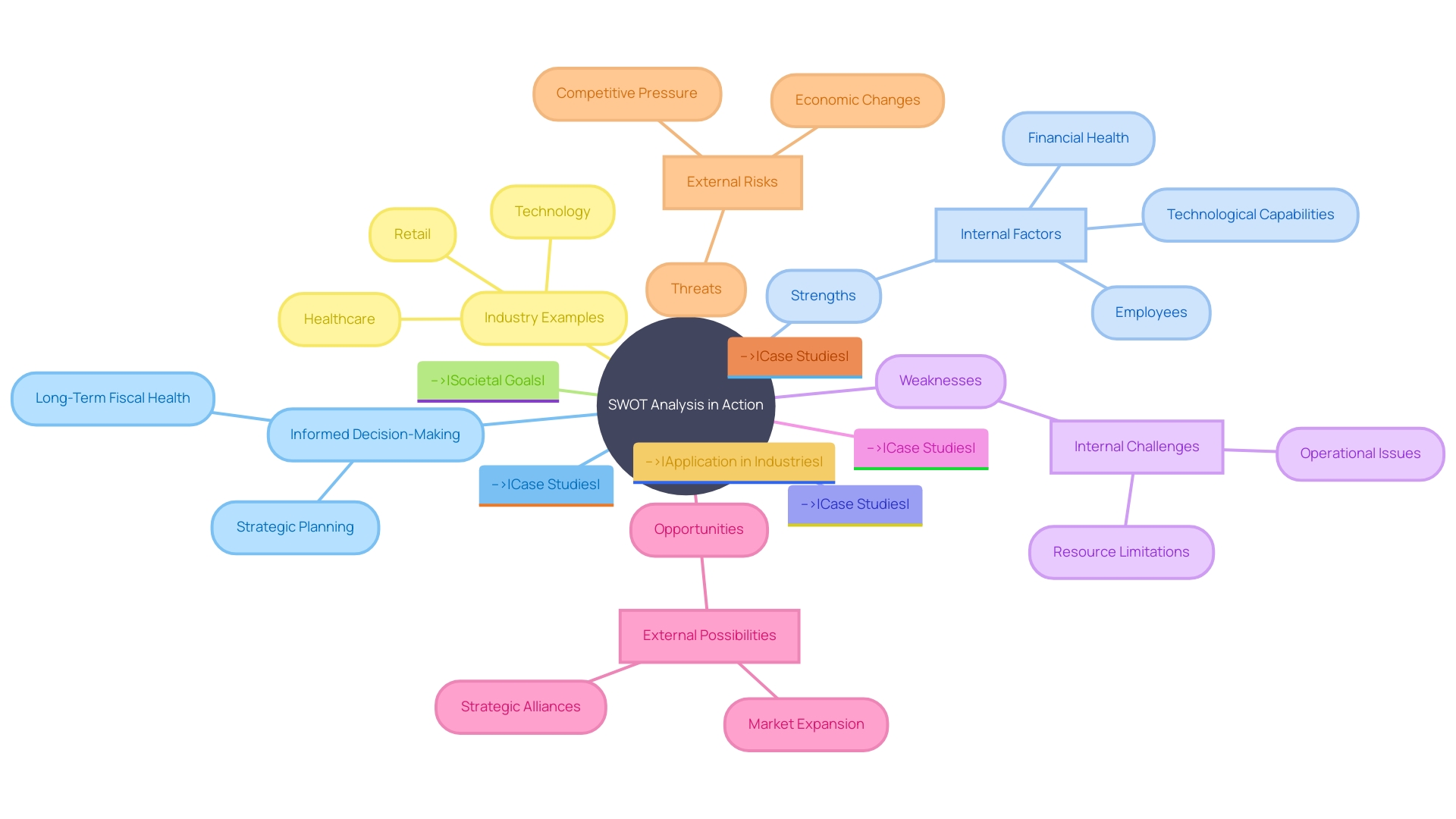
Conclusion
In conclusion, a SWOT analysis provides businesses with valuable insights into their internal strengths, weaknesses, external opportunities, and threats. This analysis guides strategic decision-making and helps organizations adapt to the ever-changing business landscape.
By conducting a SWOT analysis, businesses can identify their competitive advantages, proactively manage weaknesses, seize growth opportunities, and mitigate potential threats. This comprehensive view of the business environment enables organizations to make informed decisions and develop effective strategies.
To perform a SWOT analysis, organizations gather data and evaluate internal and external factors, allowing them to understand their market position and make strategic choices. Real-world examples demonstrate the practical application of the SWOT analysis, showing how organizations leverage their strengths, address weaknesses, and respond to external factors.
To transform SWOT analysis insights into action, businesses should leverage their strengths to seize emerging opportunities, address weaknesses to strengthen their operations, and mitigate threats to protect their standing in the market. This requires continuous strategic alignment with the business environment and a focus on long-term success.
Additional resources, such as case studies and industry examples, are available to support businesses in applying the SWOT analysis effectively and making informed decisions. These resources showcase successful strategies and highlight the importance of understanding one's own strengths and weaknesses.
In conclusion, by embracing the SWOT analysis, businesses can gain valuable insights, make strategic choices, and create action plans that drive long-term success. The SWOT analysis is a powerful tool that helps organizations leverage their strengths, overcome weaknesses, seize opportunities, and navigate threats to achieve their goals.




